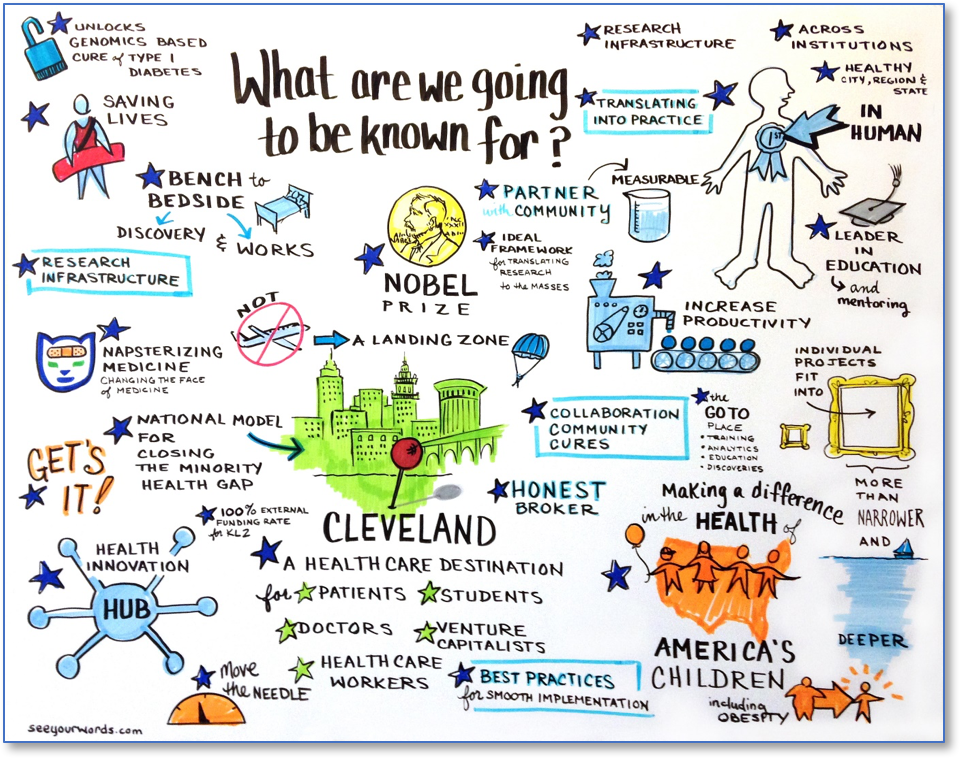Hello! We are Clara Pelfrey, Translational Research Evaluation TIG Chair and evaluator for the Clinical and Translation Science Collaborative (CTSC) at Case Western Reserve University, and Johnine Byrne, a graphic recorder and owner of See Your Words. We’d like to introduce you to graphic recording (GR), a valuable tool for evaluators that we’ve used in research, technology and collaboration settings.
What if you could capture a meeting’s ideas and energy and use them to evaluate a program, to generate qualitative data or to motivate future change? You can, because a picture is worth 60,000 words. According to Business 2 Community author Rita Pant, ninety percent of the information sent to the brain is visual, and 93% of all human communication is visual. Why not harness all that power for evaluation?
Graphic recording (GR) is a visual capturing of people’s ideas and expressions – in words and drawings – and can be a catalyst for generating new ideas, for aiding comprehension, or to help people see emerging patterns in group interactions. At a CTSC retreat, we asked attendees “What are we going to be known for?” and used the GR to develop evaluation questions and as a future vision of our research collaborative.
Hot Tip:
As an evaluator, how can graphic recording (GR) help you?
- Assessing stakeholder program readiness for evaluation, as recommended by Michael Quinn Patton in the Essentials of Utilization-Focused Evaluation.
- Brainstorming. People see their ideas take shape, increasing participation in the meeting and reducing distractions. The GR reminds them of what transpired and motivates them to take action.
- Creating timelines. Demonstrates where the group came from and where they are heading. It reminds them of future goals and how they fit into making that vision a reality.
- Capturing a dynamic talk. Can’t remember what a talk was about? You will if it’s captured in drawings!
- Promoting your organization. The GR image is used in social media, advertising and newsletters.
- World Café. Large group meetings use GR to engage everyone in a dialog and all are encouraged to draw.
Lessons Learned:
Examples of how graphic recording (GR) be useful in evaluating research, technology and collaboration:
- A medical device manufacturer used GR at an all-hands meeting to work through a major glitch in their manufacturing process. They brainstormed solutions and ways to get past roadblocks.
- A world-renowned medical research center used GR as a tool to promote communication between research groups working in the same institution. Once attendees viewed the GR they could see the possibilities, promoting the creation of new collaborations.
- A researcher used GR in her focus groups. Participants saw what others had said and they wanted to be heard too, increasing participation and promoting emergence of different viewpoints.
Rad Resources:
- Find a graphic recorder at the International Forum of Visual Practitioners.
- Can’t find a graphic recorder? Buy a ready-made template called a “visual planning system” from the Grove. It is similar to a fill-in-the blank logic model, but without all the evaluation terminology.
The American Evaluation Association is celebrating Research, Technology and Development (RTD) TIG Week with our colleagues in the Research, Technology and Development Topical Interest Group. The contributions all this week to aea365 come from our RTD TIG members. Do you have questions, concerns, kudos, or content to extend this aea365 contribution? Please add them in the comments section for this post on the aea365 webpage so that we may enrich our community of practice. Would you like to submit an aea365 Tip? Please send a note of interest to aea365@eval.org. aea365 is sponsored by the American Evaluation Association and provides a Tip-a-Day by and for evaluators.

